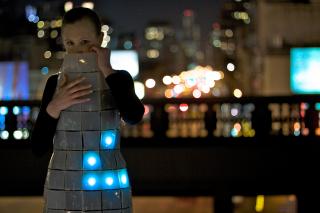
Elizabeth Fuller
Life Dress
The Life Dress is a wearable piece, depicting the symbiotic relationship of living organisms through an array of LEDs embeded in a dragon skin dress running Conway's Game of Life.
http://itpblog.efuller.net/?tag=life-dress

Classes
Introduction to Physical Computing (Wed),Materials and Building Strategies
Introduction to Physical Computing (Wed),Materials and Building Strategies
It is a challenge to find the right interactive balance within groups of people. We can be overwhelmed if we stretch ourselves too thin. Yet, we have a fundamental need for interaction just to survive.
This is reflected in the life and death cycles of LEDs on the Life Dress. Conforming to the rules developed in Conway’s Game of Life, LEDs turn on if the cells they represent are “alive” or off if the cells are “dead.” Whether a cell is born, survives, or dies is determined by the condition of other cells. A lone cell cannot survive by itself. Similarly, too many companions can overwhelm a cell. Thus, this algorithm expresses the interdependence of individuals.
The dress is a simple, mid length, layered piece. Remaining reminiscent of the grid form of Conway's Game of Life, this dress is a two-dimensional square grid of LEDs wrapped around the body, creating a fitted dress. The light of the LEDs is diffused by tiles of dragon skin that the LEDs are embedded in.
Furthermore, the dress has the potential to run a variety of algorithms loaded onto the Arduino microcontroller. Each LED is individually turned on and off through the microcontroller and a series of LED drivers. Thus, the dress could be programmed write messages, create images, or interact with external sensors.
Implementation
The piece is made of dragon skin, LEDs, wires, and the Arduino that runs it. LEDs are cast in tiles of dragon skin which are then shaped, connected, and wired into the dress.
I have detailed my work process and some how to demonstrations of mold making and latex pouring in my blog: http://itpblog.efuller.net/tag/life-dress/
Conclusion
Dragon skin is incredibly messy and even more fun.
This is reflected in the life and death cycles of LEDs on the Life Dress. Conforming to the rules developed in Conway’s Game of Life, LEDs turn on if the cells they represent are “alive” or off if the cells are “dead.” Whether a cell is born, survives, or dies is determined by the condition of other cells. A lone cell cannot survive by itself. Similarly, too many companions can overwhelm a cell. Thus, this algorithm expresses the interdependence of individuals.
The dress is a simple, mid length, layered piece. Remaining reminiscent of the grid form of Conway's Game of Life, this dress is a two-dimensional square grid of LEDs wrapped around the body, creating a fitted dress. The light of the LEDs is diffused by tiles of dragon skin that the LEDs are embedded in.
Furthermore, the dress has the potential to run a variety of algorithms loaded onto the Arduino microcontroller. Each LED is individually turned on and off through the microcontroller and a series of LED drivers. Thus, the dress could be programmed write messages, create images, or interact with external sensors.
Implementation
The piece is made of dragon skin, LEDs, wires, and the Arduino that runs it. LEDs are cast in tiles of dragon skin which are then shaped, connected, and wired into the dress.
I have detailed my work process and some how to demonstrations of mold making and latex pouring in my blog: http://itpblog.efuller.net/tag/life-dress/
Conclusion
Dragon skin is incredibly messy and even more fun.

